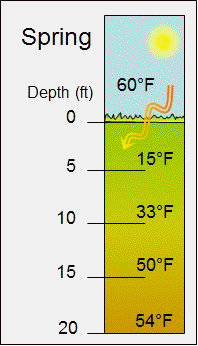Understanding the Earth Beneath Us
Understanding the earth and how it behaves, particularly thermally, is key to Earth Sheltered home design.
The earth is not some magical heat sink or constant temperature material that so many people believe it to be. It can conduct and store heat in a way that is very similar to other materials. It has a specific heat capacity less than 1/4th the specific heat capacity water, and its R value is about 1/12th of rigid insulation. So, pound for pound, it is not the best heat storage medium and is a relatively poor insulator. However, we have a lot of it and it is, as everyone knows, dirt cheap (or even free).
It is well know that the temperature of the earth is relatively constant. In south eastern Michigan, it is about 54 degrees Fahrenheit 20ft below the surface. Further south, it can be even higher. This constant temperature is roughly the average of the air temperature over a period of time. The air exchanges heat with the earth, which stores it and slowly conducts it downward. In the winter, this reverses and the earth slowly gives up its heat to the cooler air and the earth cools as its energy is conducted toward the surface. In both directions, the earth has a somewhat moderating effect on the climate, which (in addition to the larger effect of water doing the same thing) is why the air temperatures lag behind the seasons. Some refer to this heat stored in the ground as “geothermal”, but really is just a form of stored solar energy. True geothermal energy is found near tectonic fault lines (due to friction between the plates of the earths crust) or deep (miles) within the earth, emanating from the earths core ( actually due radioactive decay and friction caused by gravitational forces as the massive core of the earth interacts with the moon )… but I digress…
This thermal exchange with the mass of the earth is slow enough that, increasing with depth, daily changes and even seasonal changes in the air are moderated (averaged out). At the 20ft depth, the soil temperature is stable, roughly averaging the whole year. Actually, there are a variety of other smaller influences including reflectivity and permeability of the ground cover, transpiration of plants, the water table, etc., The net effect of these influences tends to keep the temperature a little below the average air temperature.
At about 10ft below the surface, the temperature is said to be roughly the average of the past 6 months of air temperature ( not quite, see the results of my experiment). This convenient “thermal capacitance” means the earth temperature at this depth is at its warmest when the air temperature is the coldest. Over the next 6 months, it cools until it is at its coolest just before the air temperature is the hottest.
When we place a home in the ground and start to control the temperature in the home, the soil temperature profile starts to change. The soil temperatures near our home adjust to an average of the air temperature we prefer in the home (rather than averaging the extremes outdoors). If our means of heating or cooling the home is interrupted, the thermal inertia in the walls and earth can continue to moderate the environment within our homes.

